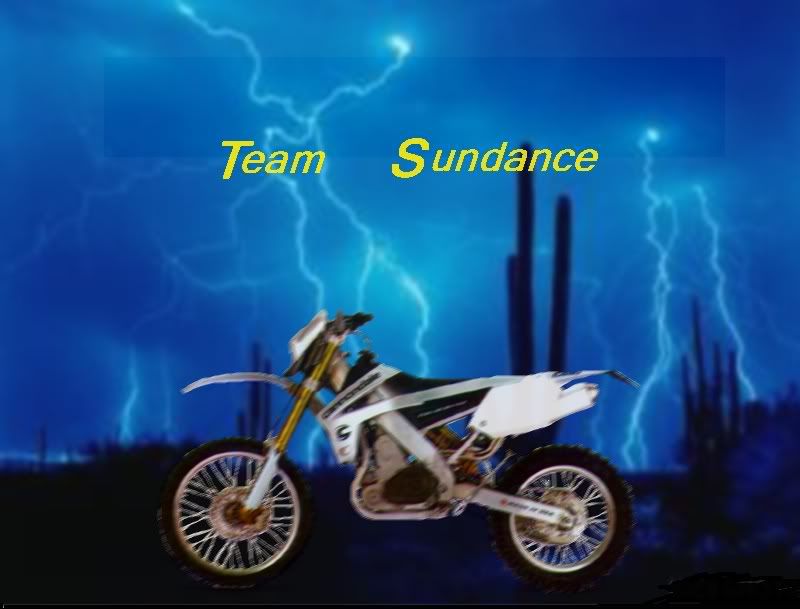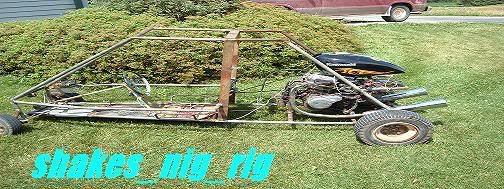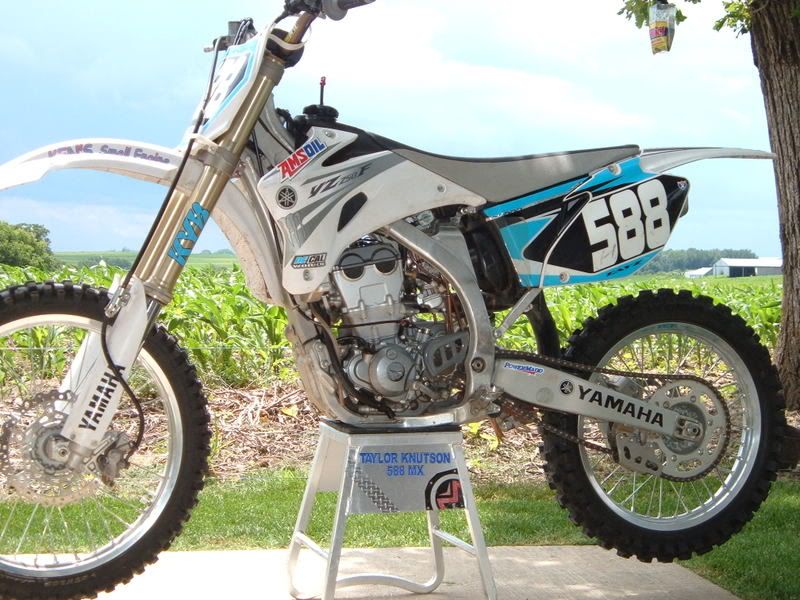Post by Master Yoda on Aug 29, 2005 9:05:44 GMT -5
I remebered reading this sometime ago... Rod Falkner knows more than anyone (except maybe Lee Petty) on how to make a motor run and run long and strong.
Anyhow I now its a bit long but if your motonutz care about you bikes you'll read what he has to say about making a motor run and last.
--------------------------------------------------------------------------------
There are a lot of people in this world who know how to make quick horsepower. On the street-racing scene, the import tuner world loves nitros oxide. In our world, everyone loves high compression. But the problem with these quick fixes is a minor detail called durability. More power equals more wear and tear on motor components. At high rpm, things like main bearings, piston rings, piston skirts and top-end bearings build heat and suffer from lubrication failure.
When it comes to engine durability, one of the most-savvy individuals in the world is Rod Falkner. In 1985 he created a company called Dumonde Tech Racing Oils, which has built a cottage industry making special lubricants. He's a paid consultant and engine tuner, and also spent 15 years as a failure analyst studying engines for NASCAR, Champ Car, karting, and motorcycling. He looks at damaged engine components much like an FAA investigator studies a crash scene. He's not a guy trying to shove his products down your throat. In fact, he says that he's "never seen an engine failure due to the quality of oil. It's always been human error or lack of lubrication, not the particular brand of oil. Oil will break down and need to be changed, but that's an entirely different subject. If an engine is designed, tuned and broken-in correctly, you should be able to run any oil with the right specifications without fear of failure. Most engine oils nowadays are about performance."
Falkner's goal is to educate people on the amazing dynamics of an engine. He's a regular guy with a knack for being able to show people how to get the most out of your piston and ring(s). So how smart is this guy? Well, he's the first to make a turbo-charged 125cc two-stroke hit triple-digit speeds at Bonneville. He'll probably be the first guy to make a non-streamliner eighth-liter motor go over 130mph!
I first met Falkner 17 years ago, but I really didn't know him until now. It took me a while to find out that he's helped establish records in everything from the shortest landing and take off for a bush plane to the North American Tour Car Championship. He's also contributed to Jet Ski National and World Championships, NASCAR titles, Barry Hawk's success in the GNCC Series and Dirt Rider's three land speed records at Bonneville's 2004 Speed Week.
Ken Faught: What's the most common misconception about engine failure?
Rod Falkner: Blaming the oil. If the engine is properly designed, tuned and balanced, and has the correct amount of oil volume, the oil will not cause engine failure. High performance oils are most definitely a protector for the engine—and will extend the life of the engine—but rather than blaming the oil when there is a failure, the savvy crew needs to look beyond the oil to the actual root of the failure or they will repeat the same mistake.
Why should people break-in a motor, and do you recommend the same procedure for two-strokes and four-strokes?
One of the key things our research has shown us is that the break-in is the most beneficial and economical thing you can do to help a motor. The first few hours the engine is run will dictate its durability and performance for the rest of its life or until its major components are replaced. This is true whether it is an Indy car motor, a two-stroke dirt bike or a four-stroke machine. Four things have to be achieved by the break in:
1. Ring seat
2. De-stressing the components
3. Work hardening the components
4. Using the process to take new metal and impregnate it with certain elements that you want to have in the motor.
What causes engine failure?
Human error!
When is an engine most vulnerable?
It depends somewhat on the engine. As a rule, it is when beer is involved with the assembly! (Laughs) But actually, engines are most vulnerable when they are new, at lower RPMs, when heat (atmospheric or internal) is involved, or when they suffer from lack of lubrication. And of course—in racing conditions—when the engines are being stressed to death.
Is heat your friend or foe?
Both. The engine needs heat to work properly, but at some point heat becomes a four-letter word. It also creates pre-ignition and detonation; it melts pistons, burns valves, blows the tips off spark plugs and robs power. If you think about it, most of the things engine builders do is to manage heat. They do this through ignition timing, valve or port timing, combustion chamber design, managing compression and also by working with carburetion or injection and the exhaust system.
What is the biggest misconception about oil?
In two-strokes many people believe that oil will lean out the engine—our research never shows that. In fact our research shows that with certain oil designs we can increase horsepower. We have also learned that one oil cannot satisfy all engines. That is why we build 52 different oils. We look at each engine, determine its needs and then design an oil specifically for it. That's one of the reasons we have such great success.
Where do people go wrong with tuning?
They get too aggressive. A rich engine and a lean engine have very similar responses, and it takes many years of experience to tell the difference. As you know from working with me, I believe "when in doubt, build it stout." We always add fuel and work from there.
Should people learn how to read a spark plug?
Yes! But we put less emphasis on the actual spark plug these days. Reading the plug stems from the old V8 engines, where it was difficult to see inside the engine to learn what was going on with it. With two-stroke engines, I prefer to pull the pipe and read the exhaust side of the piston as if it were the plug. In four-stokes, we pull the pipe and study the exhaust carbon or residues. With modern technology, we also use scopes to study the combustion chamber and the valve, and we rely heavily on data acquisition.
What is the biggest challenge racing at a place like Bonneville?
Boy, where do I start? The weather doesn't change in hours or days—it changes in minutes. Bonneville is not like any other form of racing that we've been involved in. It is a tuner and engine developer's nightmare. There are the temperature extremes, the moisture that sits right off the salt, the salt vapor that goes inside the engines, the atmospheric heat which can go up to 112°, the adjusted altitude, even the overall distance the bikes have to pull. And once you think that you might have it figured out, you wake up the next morning, and the conditions for the record-return run are completely different.
What was the purpose of building the turbo-charged Honda CR125R?
We had lots of reasons. As far as we were aware nobody has ever successfully built a true single-cylinder turbo-charged two-stroke. We know that there has been success in bigger cylinder engines, but the challenges in a single cylinder were interesting. There was no commercially available turbo for an engine that small; the smallest one we found was for a 250cc motor. So that became an interesting thing to build. Besides building one of very few tiny turbos—possibly the one and only—we had the interest in going for records at Bonneville. Our company has always pushed the envelope and gone where few have gone, because we find that the journey brings us knowledge that we can use on many projects. We thought creating the turbo might bring us closer to developing two-stroke engines with significantly reduced noise and exhaust emissions. In the short amount of time this turbo has run, we've gotten a tremendous amount of information that we never would have learned from any other source.
What are your goals with the turbo land speed record machine?
I am very interested in continuing its development. We'd like to learn how to take advantage of the amount of horsepower that we've seen it produce. We also feel that this is an important part of the puzzle that will help us to refine two-strokes. The two-stroke engine is the perfect example of efficient combustion. We have "Save The Two-Stroke" t-shirts. I really believe that the two-stroke engine is both the past and the future. It doesn't need to be saved; what it needs is to be developed into the clean, fuel-efficient powerhouse I know it can be.
Anyhow I now its a bit long but if your motonutz care about you bikes you'll read what he has to say about making a motor run and last.
--------------------------------------------------------------------------------
There are a lot of people in this world who know how to make quick horsepower. On the street-racing scene, the import tuner world loves nitros oxide. In our world, everyone loves high compression. But the problem with these quick fixes is a minor detail called durability. More power equals more wear and tear on motor components. At high rpm, things like main bearings, piston rings, piston skirts and top-end bearings build heat and suffer from lubrication failure.
When it comes to engine durability, one of the most-savvy individuals in the world is Rod Falkner. In 1985 he created a company called Dumonde Tech Racing Oils, which has built a cottage industry making special lubricants. He's a paid consultant and engine tuner, and also spent 15 years as a failure analyst studying engines for NASCAR, Champ Car, karting, and motorcycling. He looks at damaged engine components much like an FAA investigator studies a crash scene. He's not a guy trying to shove his products down your throat. In fact, he says that he's "never seen an engine failure due to the quality of oil. It's always been human error or lack of lubrication, not the particular brand of oil. Oil will break down and need to be changed, but that's an entirely different subject. If an engine is designed, tuned and broken-in correctly, you should be able to run any oil with the right specifications without fear of failure. Most engine oils nowadays are about performance."
Falkner's goal is to educate people on the amazing dynamics of an engine. He's a regular guy with a knack for being able to show people how to get the most out of your piston and ring(s). So how smart is this guy? Well, he's the first to make a turbo-charged 125cc two-stroke hit triple-digit speeds at Bonneville. He'll probably be the first guy to make a non-streamliner eighth-liter motor go over 130mph!
I first met Falkner 17 years ago, but I really didn't know him until now. It took me a while to find out that he's helped establish records in everything from the shortest landing and take off for a bush plane to the North American Tour Car Championship. He's also contributed to Jet Ski National and World Championships, NASCAR titles, Barry Hawk's success in the GNCC Series and Dirt Rider's three land speed records at Bonneville's 2004 Speed Week.
Ken Faught: What's the most common misconception about engine failure?
Rod Falkner: Blaming the oil. If the engine is properly designed, tuned and balanced, and has the correct amount of oil volume, the oil will not cause engine failure. High performance oils are most definitely a protector for the engine—and will extend the life of the engine—but rather than blaming the oil when there is a failure, the savvy crew needs to look beyond the oil to the actual root of the failure or they will repeat the same mistake.
Why should people break-in a motor, and do you recommend the same procedure for two-strokes and four-strokes?
One of the key things our research has shown us is that the break-in is the most beneficial and economical thing you can do to help a motor. The first few hours the engine is run will dictate its durability and performance for the rest of its life or until its major components are replaced. This is true whether it is an Indy car motor, a two-stroke dirt bike or a four-stroke machine. Four things have to be achieved by the break in:
1. Ring seat
2. De-stressing the components
3. Work hardening the components
4. Using the process to take new metal and impregnate it with certain elements that you want to have in the motor.
What causes engine failure?
Human error!
When is an engine most vulnerable?
It depends somewhat on the engine. As a rule, it is when beer is involved with the assembly! (Laughs) But actually, engines are most vulnerable when they are new, at lower RPMs, when heat (atmospheric or internal) is involved, or when they suffer from lack of lubrication. And of course—in racing conditions—when the engines are being stressed to death.
Is heat your friend or foe?
Both. The engine needs heat to work properly, but at some point heat becomes a four-letter word. It also creates pre-ignition and detonation; it melts pistons, burns valves, blows the tips off spark plugs and robs power. If you think about it, most of the things engine builders do is to manage heat. They do this through ignition timing, valve or port timing, combustion chamber design, managing compression and also by working with carburetion or injection and the exhaust system.
What is the biggest misconception about oil?
In two-strokes many people believe that oil will lean out the engine—our research never shows that. In fact our research shows that with certain oil designs we can increase horsepower. We have also learned that one oil cannot satisfy all engines. That is why we build 52 different oils. We look at each engine, determine its needs and then design an oil specifically for it. That's one of the reasons we have such great success.
Where do people go wrong with tuning?
They get too aggressive. A rich engine and a lean engine have very similar responses, and it takes many years of experience to tell the difference. As you know from working with me, I believe "when in doubt, build it stout." We always add fuel and work from there.
Should people learn how to read a spark plug?
Yes! But we put less emphasis on the actual spark plug these days. Reading the plug stems from the old V8 engines, where it was difficult to see inside the engine to learn what was going on with it. With two-stroke engines, I prefer to pull the pipe and read the exhaust side of the piston as if it were the plug. In four-stokes, we pull the pipe and study the exhaust carbon or residues. With modern technology, we also use scopes to study the combustion chamber and the valve, and we rely heavily on data acquisition.
What is the biggest challenge racing at a place like Bonneville?
Boy, where do I start? The weather doesn't change in hours or days—it changes in minutes. Bonneville is not like any other form of racing that we've been involved in. It is a tuner and engine developer's nightmare. There are the temperature extremes, the moisture that sits right off the salt, the salt vapor that goes inside the engines, the atmospheric heat which can go up to 112°, the adjusted altitude, even the overall distance the bikes have to pull. And once you think that you might have it figured out, you wake up the next morning, and the conditions for the record-return run are completely different.
What was the purpose of building the turbo-charged Honda CR125R?
We had lots of reasons. As far as we were aware nobody has ever successfully built a true single-cylinder turbo-charged two-stroke. We know that there has been success in bigger cylinder engines, but the challenges in a single cylinder were interesting. There was no commercially available turbo for an engine that small; the smallest one we found was for a 250cc motor. So that became an interesting thing to build. Besides building one of very few tiny turbos—possibly the one and only—we had the interest in going for records at Bonneville. Our company has always pushed the envelope and gone where few have gone, because we find that the journey brings us knowledge that we can use on many projects. We thought creating the turbo might bring us closer to developing two-stroke engines with significantly reduced noise and exhaust emissions. In the short amount of time this turbo has run, we've gotten a tremendous amount of information that we never would have learned from any other source.
What are your goals with the turbo land speed record machine?
I am very interested in continuing its development. We'd like to learn how to take advantage of the amount of horsepower that we've seen it produce. We also feel that this is an important part of the puzzle that will help us to refine two-strokes. The two-stroke engine is the perfect example of efficient combustion. We have "Save The Two-Stroke" t-shirts. I really believe that the two-stroke engine is both the past and the future. It doesn't need to be saved; what it needs is to be developed into the clean, fuel-efficient powerhouse I know it can be.









